On nowadays late Geektimes there is (or was) a blog Gearbest and it was (or is) sad. For some reason, their marketers are repeatedly introducing the same phones and tablets, while the site (however, like Ali) has a bunch of other great products for geeks. Therefore, can I share my little Chinese discoveries?

I have children. Children = discarded batteries. Those. there are also intermediate links like big robots, swords screaming robokoshek, which roll around the house and flicker like an epileptic dream and so on. But everything leads to one - thrown batteries.
Thanks to Alexey Nadezhin, we already
know that the best in terms of price / capacity ratio are either Ikea and Auchan batteries, or GP Super. Those actually lived.
UPD : in the comments indicated that Alexey conducted a new study. With the price upgrade to current, it turns out that the Pairdeer and Lexman batteries from Leroy Merlin look better. Well, again Auchan.However, having dumped another portion of dead batteries into a special container and having experienced the midnight cry of Yaroslavl that the favorite doll does not work, came to a simple conclusion - it’s time to switch to batteries. Moreover, if there are batteries, it would be nice to charge them somehow. Got to google simple charges and then I discovered “about a brave new world”.
Part One, Batteries
Since toy manufacturers use standard formats (and, judging by the prices of batteries in children's stores, they also pay extra for it, so it’s better to look for this margin, and banned drugs), let us consider AA and AAA.
One of the best batteries in the world are Japanese Eneloop. They have a large capacity, high charge / discharge currents and, most importantly, low self-discharge. Those. for three years of storage, they lose about 15-25% of the charge. Interestingly, the appearance of such batteries in the mass segment, we are obliged to some extent by Fukushima. LSD batteries (an abbreviation denoting low self-discharge) began to be added to “emergency kits” and the ability to save energy for a long time became one of the most important factors. Therefore, as a rule, eneloop is sold already charged, and the manufacturer especially emphasizes that they are charged with “very green energy”.
So, Eneloop are good in everything, except for the price. The most affordable option for purchase is a company store on Ali, where you will have to pay
1000 rubles for 4 AA batteries. And for the version of Eneloop Pro (characterized by a larger capacity, but 4 times less charge cycle: 500 vs. 2100 times) - 1,700 rubles. You can find it cheaper, but it’s still damn expensive.
However, if you go to the same Ikea, you will
see suspicious, similar
Ladda batteries with one-to-one characteristics with Eneloop Pro on the shelves. In this case, the price they will have is only 500 rubles for a set of 4 AA and 400 rubles for a set of 4 AAA. And it seems that they
are made in the same factory as the Eneloop.
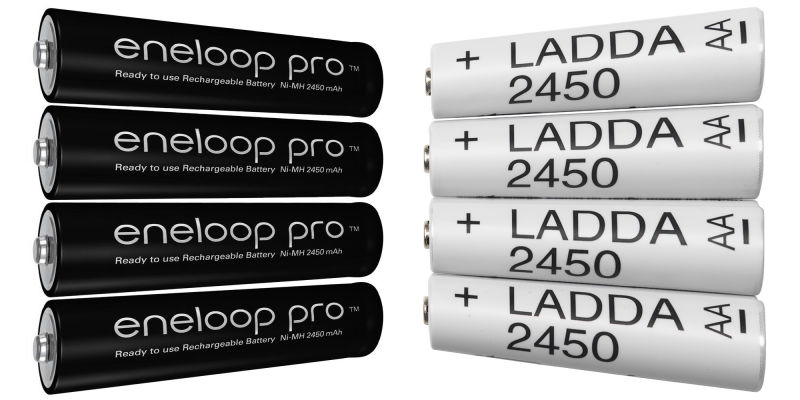
Therefore, if you only buy batteries - look for something else simply does not make sense. In my humble opinion, this is the best offer for the price / capacity of all that is on the market. Of course, confusing low number of charge cycles, however, if you use them like me - in children's toys, then you lose them faster than they degrade.
Another moment. Buying batteries is better than one brand. Because different batteries can differ both in capacity and in the characteristic of voltage reduction. Someone works better in one voltage range, someone in another. As a result, it can badly affect all batteries in combination and lead to their earlier degradation. Therefore, a simple rule - buy in sets and put the same batteries in the devices.
Part two (interesting). About charging
Recently, my children had temperature, were sitting at home and the batteries were leaving with a special speed, and I read and read about batteries and charging. These surveys led to the writing of the text - because, damn, it's interesting and I want to share the accumulated material.
I will say right away that I am not a real welder and even a little blond in currents and electrics. But, I’ve been reading and now, like most people on the Internet, I can think wisely about things that I don’t understand. Therefore, according to me, the charges are divided into ordinary, good and confused.
Ordinary (read, bad)
Such charges are usually sold under the brand of the battery manufacturer and can only charge batteries. Moreover, FIG understand what currents, usually pars and without any indication of the battery status.

Why this is bad: firstly, when charging in pairs, the charger is guided by the weakest / degraded battery and as a result you will have more than one degraded battery, but a pair. Without state control, you will not know which of them is half-dead and throw both away.
Secondly, AA and AAA batteries are usually NiMh. This means that these batteries have a memory effect. Regularly charging an underdischarged battery in normal charging, you ruin both himself and his pair. Thus, the usual charge - evil.
Good charge
Good charges already know how to charge each of the slots individually, show the voltage of each battery, automatically cut off the charge to achieve 100% (we will talk about how this is done a little further). And, the most important thing for NiMh - they are able to do a discharge-charge cycle for full charge or a charge-discharge-charge cycle for removing the memory effect. The confused ones are additionally able to do 3 charge-discharge cycles for training newly purchased batteries and restoring the capacity of partially degraded ones.
Why do we need such dances? Fully charged batteries have a voltage of 1.5 V ...
Here, by the way, my personal misunderstanding, because as always and everywhere it is said that batteries have a voltage of 1.5; and batteries - 1.2. As I understand it, 1.2 is the average operating voltage, and in batteries it is, average, higher. I would be grateful for the educational program in the comments.
When the voltage reaches 1.1..1V, the equipment usually starts yelling about the dead batteries. However, the lower value for such batteries is 0.9 V. Since we remember the memory effect (to be fair, NiMh is less susceptible to it than NiCd, but it is), to achieve full capacity, it would be nice to discharge batteries with a certain frequency and then charge.
Another thing connected with the children is that when picking out batteries from another abandoned toy, I often have no idea how discharged they are. Therefore, in my case, the most optimal option is to discharge “to zero” and then charge. Good charging can do it automatically.
And finally - if the battery is discharged below 0.9 V (for example, in a flashlight that is not turned on), normal charging may not see it at all. But a good charge, and even more confused, will be able to slowly recharge it to 0.9 V, and then charge it as usual.
And here we go to specific models.
If you need to charge only nickel (i.e., only AA and AAA batteries, NiMH and NiCd technology), then Opus BT-C700 is considered optimal (I don’t provide links, but charging is easily looked at both on Ali and Gearbest) . Charging, as I understand it, at one time was successfully lapped with Lacrosse, but it is three times cheaper.

What can:
- Serve 4 batteries independently;
- To charge by currents 200,300,400, 500,700,1000 mA;
- Charge the battery to full capacity;
- Discharge to 0.9V;
- Capacity test: charge / discharge / charge cycle with display of “drained” capacity during discharge;
- Restore (train) by a three-time charge / discharge cycle.
Charging is one of the most affordable, the price of it was about 1200-1300 rubles. However, despite its versatility, I do not like it.
Minuses:
- Charging does not know how to charge Li-ion (and more and more of these batteries);
- In most of the output modes, I get either a discharged battery, which requires starting the charging again, or — as in the capacity test mode — an extra charge cycle at the beginning. It is clear that this is more correct - because it is still a test. But these extra cycles or extra presses - they strain.
- With a full battery, charging still continues with low currents to avoid self-discharge. As far as I understand, this is bad for LSD batteries.
Therefore, I love another exercise, which is even cheaper than Opus. This is Liitokala Lii-500.

What can:
- Serve 4 batteries independently;
- Charge Li-ion batteries;
- To charge with currents of 300, 500, 700, 1000 mA;
- Charge the battery to full capacity;
- Quick test: discharge-charge mode (the most for my needs);
- Big test: charge-discharge-charge mode ";
- Work as power bank with current in 1A.
As you can see, nothing superfluous. Simple and reliable tool. However, she has flaws.
- The format 18650 climbs right into it, especially with the protection board. Due to the not-so-convenient cut-out, batteries of this type are difficult to attach and scratch their packaging easily. As a result, 5-10 cycles, and the battery is shrunk.
- The problem is with a high minimum charge current, which, theoretically, is not good for AAA batteries.
Let's talk about the latter in detail, because there are a lot of myths and pitfalls. So, there are three approaches to the problem:
- The battery (especially the old, NiCd) must be charged with currents of 0.1 of its capacity. Those. with an AAA battery capacity of 500 mAh, its charge current should be no more than 50 mA (hello-arrived). A normal LADDA, with a capacity of 900 mAh, then somewhere around 100 mA.
- Many charging work using the “-dV” method, according to which charging monitors the battery voltage and considers it fully charged when an abrupt voltage change occurs (called “catching the delta”). The instructions usually say that for this fishing you need a current of at least 0.3 from the capacitance.
- Well, the most courageous people write that such batteries should be charged with a current equal to the battery capacity. Those. the same LADDA 2450 should be fried with current under 2.5A
Which of these approaches is correct, I honestly do not know. In favor of the second, he says that SkyRC MC3000 (which costs more than 6,000 rubles) is quite steeply charged; there is a special program for the Panasonic Eneloop (and, as we understand, for Ikea Ladda), where the battery is charged with large currents above the ampere. So for myself, I decided that the old AAA NiCd batteries I charge with a current of no more than 200 mA. But the new NiMh - already a current of 500 (in fact, such a current, many zamorochenny charge put themselves). Here I am also waiting for advice in the comments, because the question still hung in the air.
Zamorochenny charging
Since there are other formats besides nickel (NiMh) and lithium (Li-ion 4.2 V), let's briefly discuss them. First of all, we restrict ourselves to the size of 22,650 (including the protection fee). Accumulators are thicker and higher in mass charging, alas, they no longer climb (however, 22650 is already a lot). If you need to charge another format, there is a great option in the form of SKYRC IMAX B6. In my opinion, he generally charges everything that moves, and what does not move, will stir and charge. However, this is such a solution to engineers from engineers and there is no way to figure it out. Therefore, I repeat, for the time being we will restrict ourselves to massive exercises and no more than 22,650 in size. But the real 18650 is actually better.
So, In addition to Li-ion 4.2V, there is Li-ion 4.35V and such an exotic variant as LiFePO4 with a voltage of 3.7. All this economy, too, must somehow be charged.
For conventional batteries, Opus BT-3100 (v 2.2) is considered the leader in terms of price / quality.
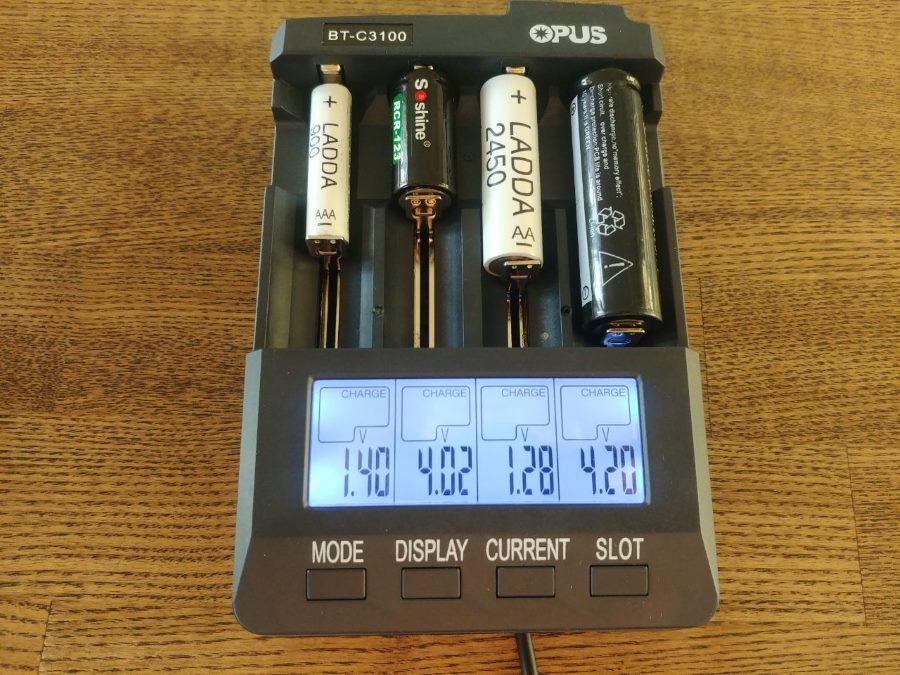
Abilities are almost the same as those of the BT-C700
- Serve 4 batteries independently;
- Charge Li-ion batteries;
- Charge with currents of 200, 300, 500, 700, 1000 (for slots 1 and 4, an additional 1500 and 2000 mA). If all 4 batteries are charged, then the maximum current for all is 1A;
- Charge the battery to full capacity;
- Discharge to 0.9V;
- Capacity test: charge / discharge / charge cycle with display of “drained” capacity during discharge;
- Restore (train) by a triple charge / discharge cycle;
- Measure battery resistance;
Interestingly, the Opus BT-3100 has become such an unofficial Chinese standard. Up to the point that some sellers of batteries on Ali began to take pictures of their “banks” right away in opus. To, so to speak, immediately demonstrate all sryaze.
 Photo of one of the shops
Photo of one of the shopsOpus doesn't have many faults.
- The built-in fan is small and regularly makes noise even on nickel. Although there, at low current, the temperatures are not said to be large. It is said that in a year or two the fan becomes clogged with dust and roars like the souls of the damned. Thank God, the problem is treated by replacing the fan (the price of the issue is about 200 rubles)
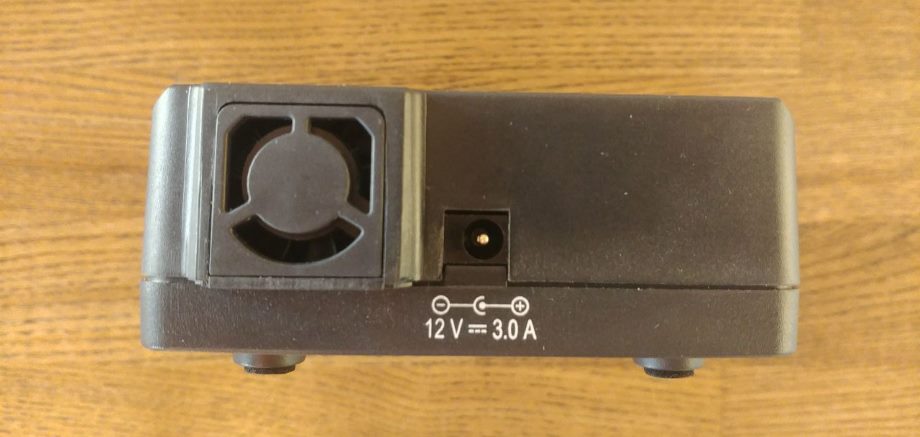
- Cheap plastic, which is specifically in my copy also smells unpleasant when heated lithium.
- To switch between Li-ion 4.2, 4.32 and LiFePO4, there is a special lever under the case. Which should be switched back and forth.
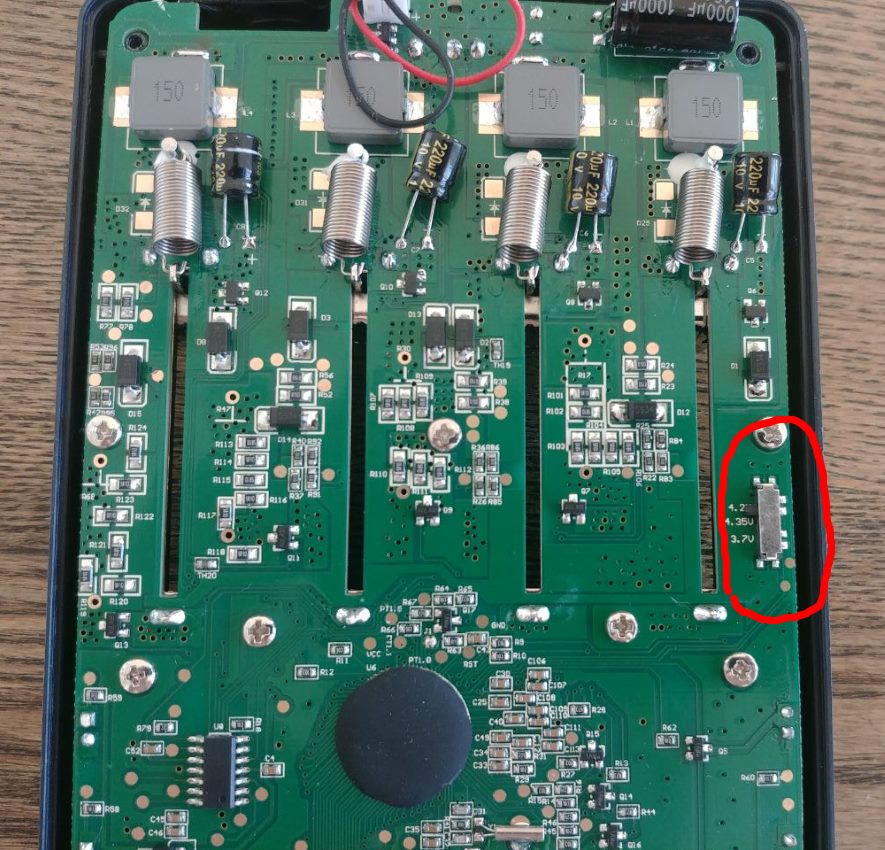
Having suffered a little from the opus (and I had several batteries with non-standard voltages in my household, for which I didn't want to crawl under the case every time) and selling it at a discount to a colleague, it was decided to look for something else. By the way, as far as I understood, the LiFePO4 mode with a voltage of 3.7 is successfully used by people to transfer Li-Ion into long storage mode (ie, 2/3 of the charge). It is not entirely clear how charging while catching the delta, but at the boundary voltage, it is usually cut off.
As the forums showed, in 2017 a new player appeared, called Miboxer. The first 4-slot model Miboxer C4 came out a little lumpy, because had problems with high charge maintenance currents after charging, which is bad for LSD. Then came the updated version, worth 1500 rubles, cured of children's defects.

What can:
- Serve 4 batteries independently;
- Charge the batteries Li-ion and LiFePO4 (4.2 and 4.35 will automatically determine LiFePO4 - you need to poke buttons);
- To charge the current in the range of 100..800 mA in increments of 100;
- In many cases, it itself sets the normal settings;
- Charge the battery to full capacity;
- Determine the battery resistance in all slots;
- Test: charge-discharge-charge mode (only in the fourth slot!);
Charging looks better than Opus. She has nice plastic and buttons. To charge AAA, a touching stand is included in the kit to improve contact. She also has a large display with all the necessary parameters.

These were subjective advantages. At the same time, hell, she has a very confusing menu that requires the presence of a number of instructions.
Minuses:
- Wise menu (honestly, you have to poke, then poke for a long time, then switch something). Thank God, she sets many things as an automaton and has to interfere infrequently.
- The discharge function (more precisely, the test) is only in one slot (arrived again).
Interestingly, charging shows real current all the time. It can be seen as in the first seconds it determines the state of the “bank” by small currents (as it is now in the photo), then it accelerates the current to the set or automatically determined. Then, when charging above 80%, reduces the current for accurate and careful charging. Well, at the very end, it accelerates the current in order to clearly “catch the delta”. Very, you know, nice. Everything is under control, the border is locked, the princess can sleep peacefully. For multiple reasons, stopped at her.
But, not having calmed down on my laurels, I also found the older model Miboxer C4-12 for 3,500 rubles. Despite the similar name, it is generally another charge. That's all. It is designed primarily for Li-ion and the number 12 in its name hints that it can charge 4 batteries at once with currents up to 3A (nickel - up to one apmer). With her, even the power supply comes as for a laptop.
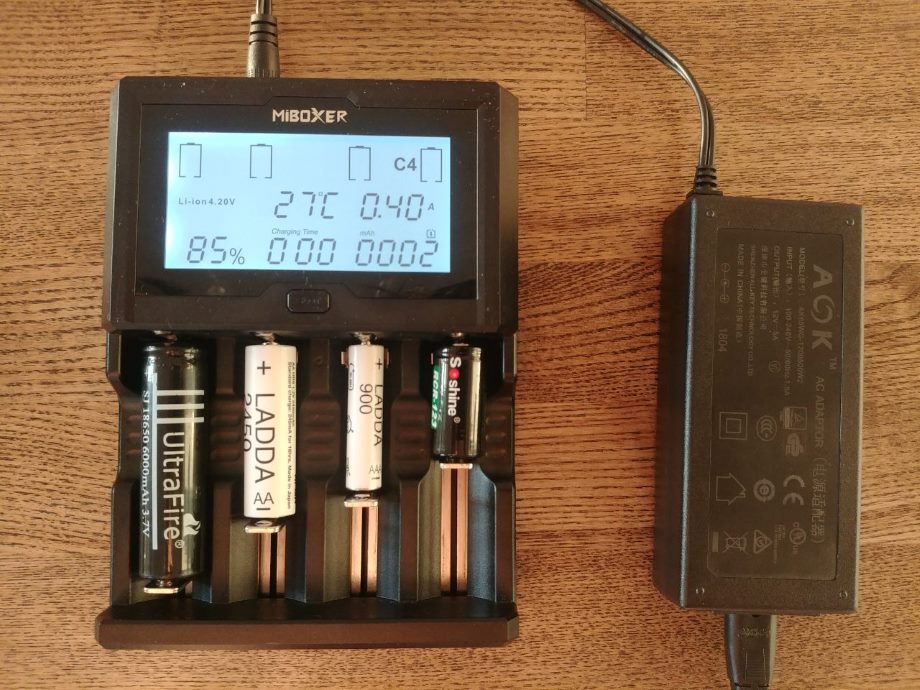
In contrast to the simple Miboxer C4, charging has lost its discharge function (they say, who needs a charge when we have 3A per slot!). They removed support for Li-ion 4.32 and LiFePO4 (we have three amps !!!). They removed a separate bar for AAA, and left only one of the two control buttons (Three-and-and-and!). As you understand, the control logic has become even more “convenient”. But on the display appeared plus one indicator - temperature, which is very nice. It's funny that the indicator of current and voltage at the same time no longer fit, and now they replace each other blinking.
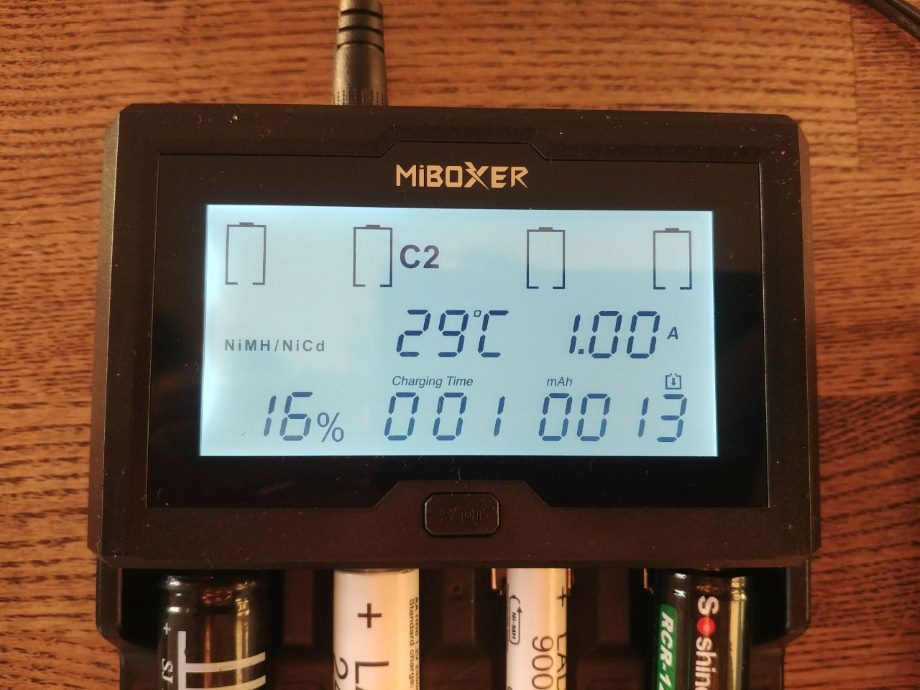
A couple of realist remarks
For completeness of impressions, you need to insert a couple of fly in the ointment. First, the simplest calculations show that batteries pay off after 7-8 cycles. If we talk about my child case - there is a chance that the batteries will be lost faster than they pay off. But the thought warms me that I am less damaging the ecology.
Secondly, it is clear that such charges will pay off mainly for professional use (especially Miboxer C4-12). Those. photographers, vapers, owners of radio-controlled models, tourists with flashlights (
and all this is one person ). However, the presence of such a charge gives a pleasant feeling of control over the process. Those. You did not just charge, but did it in a clever way. And this, damn it, heats too.